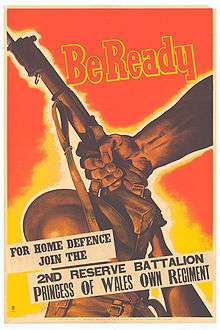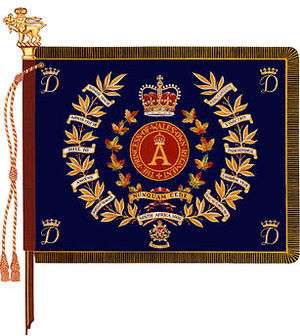Princess of Wales' Own Regiment
| The Princess of Wales' Own Regiment | |
|---|---|
|
Cap badge of The Princess of Wales' Own Regiment | |
| Active | January 16, 1863– |
| Country | Canada |
| Branch | Primary Reserves |
| Type | Line Infantry |
| Role | Light Role |
| Size | One battalion |
| Part of | Royal Canadian Infantry Corps |
| Garrison/HQ | Kingston |
| Nickname(s) | The P-Dubs |
| March | Quick: The Buffs |
| Commanders | |
| Honorary Colonel | Dr.John Scott Cowan |
The Princess of Wales' Own Regiment (PWOR) is a Primary Reserve infantry regiment of the Canadian Forces.
History
The regiment was created on 16 January 1863 as the 14th Battalion Volunteer Militia Rifles of Canada from the amalgamation of Kingston, Ontario’s seven independent rifle companies. Shortly after the wedding of the Prince of Wales (later Edward VII) to Princess Alexandra of Denmark, the regiment asked for and was given permission to become The Princess Of Wales’ Own Regiment.
During the Fenian Raid of 1866, when the Irish extremists attempted to bring Britain to her knees by attacking Canada, the regiment was called to active duty, both to Niagara and later to Cornwall. The band mace presented to the regiment by its officers "In Remembrance of Cornwall" is in the museum.
In 1885, during the Riel Rebellion the PWOR was again activated, but not for field service in the West, as it had hoped. It was destined for garrison duties at Tete-du-Pont Barracks (now Fort Frontenac) and Fort Henry.
The Boer War, in South Africa, in 1899, again brought members of the 14th to the Colours. A number of members served in various units and because of the 14th’s contribution, “South Africa 1900” became the first battle honour. As a matter of interest, a PWOR officer by the name of Major Wallace Bruce Matthews Carruthers, made his own way to South Africa, after being turned down for South Africa service, in Canada. He was "signed-on" as a Lieutenant and distinguished himself sufficiently that he was asked to join the regular force. When he returned to Canada, he was asked to set up the Canadian Signal Corps.
The outbreak of World War I in 1914 resulted in a response by members of the regiment that was quite remarkable. Very quickly a contingent of 80 men was formed under Captain George T. Richardson, (for whom George Richardson Stadium in Kingston is named—he became the PWOR’s first officer fatality) and sent to the 2nd (Eastern Ontario Regiment) Battalion Canadian Expeditionary Force (CEF), of the 1st Canadian Division, which was part of Canada’s First Contingent. At the same time, the 21st Battalion, CEF was formed in Kingston, under the Commanding Officer of the PWOR, Lieutenant-Colonel St Pierre Hughes. The PWOR also contributed officers and men to the 59th, 146th, and 253rd Battalions, CEF.
The history of the 21st Battalion, which the PWOR perpetuates, is far too long to relate here, however, it should be mentioned that the unit earned eighteen Battle Honours were won in three years of frontline service. A great deal of the 21st Battalion history, including its Colours, is found in the regimental museum. There is also a photo tribute to the 21st Battalion . The mascot of the Princess of Wales' Own Regiment during the Great War, a white goat named `Nan`, retired to the Royal Military College of Canada stables from 1918 until her death on September 22, 1924 at 12 years of age. She was buried in the Cataraqui Cemetery [1]
In 1920, in the post war re-organization of the Militia, the 14th Battalion Rifles was re-designated as a line infantry regiment so that it could carry the Battle Honours and Colours of the 21st Battalion, CEF (A rifle regiment carries its Battle Honours on its drums).
The Princess of Wales’ Own Regiment, became allied on 15 July 1926 with the South Lancashire Regiment (Prince of Wales’ Volunteers) who count among their Battle Honours Louisburg and Niagara. In the mid-1960s, the South Lancashire Regiment was amalgamated with other Lancashire regiments to form the present allied regiment- The Queen's Lancashire Regiment.

In the Second World War, the decision was made not to mobilize the regiment, because of the heavy losses suffered in the First World War. Instead, it provided one complete company to the Stormont, Dundas and Glengarry Highlanders (Glens), which went under canvas at the Kingston fairgrounds. The Glens went ashore on D-Day under a PWOR officer, Lieutenant-Colonel GH Christiansen, as part of the 9th (Highland) Brigade, commanded by another PWOR officer, Brigadier-General Douglas Gordon Cunningham.
In June 1942, the 1st battalion PWOR was formed under Lieutenant-Colonel E Cockburn and it served in Sherbrooke, Quebec and Debert, Nova Scotia, where it was deployed for east coast defence. All told, the regiment supplied 1500 men for active service including one Brigadier, four Colonels and eight Lieutenant-Colonels.
In 1963, the PWOR celebrated its Centennial, and was granted freedom of the City of Kingston. It was presented with the new Colours by the Lieutenant Governor, the Honorable Earl Rowe. On the Colours was emblazoned the badge of the Stormont, Dundas and Glengarry Highlanders, 1939–1945, commemorating the service of PWOR members in that regiment.
The PWOR went through a decline during the 1970s and 1980s, where a measure of a unit’s success was simply the ability to remain active and keep off the increasing list of once proud units now relegated to the supplementary order of battle. The regiment was reduced to a minor unit, with only one authorized company for most of the Seventies, until finally in 1978, it was again elevated to major unit status.
The regiment has always acquitted itself well in competition over the years, whether in sports, shooting or skill at arms. In 1895 the Regimental Quarter Master represented Canada at Bisley. His rifle and some of his winnings are on display in the museum. More recently a member of the unit was part of the 1990 Canadian Forces Bisley Team and a member of the unit's Cadet Corps distinguished herself on the same ranges.
Today, the regiment is composed of men and women from all walks of life including students, policemen and farmers. Members of the regiment have distinguished themselves on recent peacekeeping tours in Cyprus and the former republics of Yugoslavia.
Members of the regiment have also served on combat missions in Afghanistan during Operation Medusa.
The Freedom of the City was exercised by the Princess of Wales' Own Regiment in Kingston May 4, 2013 1963.[2]
Today, the Princess of Wales’ Own Regiment continues to maintain itself as an effective component of the ‘Total Force’ army, preparing to fulfill its role, if called upon, as a first rate infantry unit. Nunquam Cede (Never Yield)
Operational history


The Fenian Raids
The battalion was called out on active service on 8 March 1866, remaining on active service until on 31 March 1866.[3]
South African War
The regiment did not fight in the Boer War in South Africa, but contributed volunteers for the various Canadian Contingents.[4]
The Great War
Details of the regiment were placed on active service on 6 August 1914 for local protection duties.
The 21st Battalion (Eastern Ontario), CEF, was authorized on 7 November 1914 and embarked for Britain on 6 May 1915, disembarking in France on 15 September 1915, where it fought as part of the 4th Infantry Brigade, 2nd Canadian Division in France and Flanders until the end of the war. The battalion was disbanded on 30 August 1920.
The 59th Battalion (Ontario), CEF, was authorized on 20 April 1915 and embarked for Britain on 1 April 1916, where it provided reinforcements for the Canadian Corps in the field until 6 July 1916, when its personnel were absorbed by the 39th Battalion, CEF. The battalion was disbanded on 21 May 1917.
The 253rd (Queen's University) Highland Battalion, CEF, was authorized on 1 May 1917 and embarked for Britain on 29 April 1917. On 18 May 1917, its personnel were absorbed by the 5th Reserve Battalion, CEF, to provide reinforcements for the Canadian Corps in the field. The battalion was disbanded on 8 December 1917.[5]
The Second World War
Details from the regiment were called out on service on 26 August 1939 and then placed on active service on 1 September 1939, as The Princess of Wales' Own Regiment (Machine Gun), CASF (Details), for local protection duties. These details were disbanded on 31 December 1940.
The regiment provided No. 1 Company of The Stormont, Dundas and Glengarry Highlanders, CASF, for active service on 24 May 1940. The regiment subsequently mobilized the 1st Battalion, The Princess of Wales' Own Regiment (Machine Gun), CASF, on 12 May 1942. It was redesignated the 1st Battalion, The Princess of Wales' Own Regiment, CIC, CASF, on 19 July 1943. It served in Canada in a home defence role as part of Military District No. 4. The battalion was disbanded on 15 October 1943.[6]
War In Afghanistan
The regiment contributed an aggregate of more than 20% of its authorized strength to the various Task Forces which served in Afghanistan between 2002 and 2014.[7]
Alliances
Perpetuations
War of 1812: The Princess of Wales Own Regiment perpetuates the Battalion of Incorporated Militia of Upper Canada, the 1st Regiment of Addington Militia, the 1st Regiment of Frontenac Militia and the 1st Regiment of Lennox Militia.[8]
The Great War: The Princess of Wales Own Regiment perpetuates the 21st Battalion (Eastern Ontario), CEF, the 59th Battalion (Ontario), CEF and 253rd Battalion (Queen's University Highland), CEF
Battle honours and honorary distinctions

In the list below, battle honours in capitals were awarded for participation in large operations and campaigns, while those in lowercase indicate honours granted for more specific battles. Battle honours in Bold Type are emblazoned on the regimental colour.[9]
War of 1812
Honorary distinction: the non-emblazonable honorary distinction Defence of Canada – 1812–1815 – Défense du Canada[12]
Boer War
- South Africa, 1900
Great War
The Second World War
Honorary distinction: the badge of the Stormont, Dundas and Glengarry Highlanders (SD&G Highrs), with the dates 1944–1945, for jointly mobilizing the unit for service in Europe.[13]
War in Afghanistan
- Afghanistan[14]
Media
Capt. Herbert W. McBride who served with the 21st Battalion wrote two books about his experiences as a member of the unit during the Great War as a sniper and machine gunner: "A Rifleman Went To War" and "The Emma Gees."
Memorials
In May 1917, the Officers of the 21st Battalion had a cross built to commemorate their comrades lost in the hard fighting for Vimy Ridge. Private George Williams, a carpenter salvaged wood from the battlefield to make the cross, ten feet high and three feet across, which was painted white and bore a metal plaque, "In Memory of Officers, NCPs and Men; 21st Canadian Infantry Battalion Killed in Action April 9th 1917". The cross was originally erected near Thelus, France. The cross erected in Sanctuary Wood on the grounds of the Royal Military College of Canada in the 1930s. In 1994 the cross was refurbished and moved into the north wall, Regimental Armouries, 100 Montreal Street with the 21st Battalion cap badge at its feet and surrounded by the Regiment's 19 current Battle Honours. During services are held by the Regiment and Association every April, the name of every 21st Battalion soldier killed at Vimy is read aloud.[15]
The Princess of Wales' Own Regiment Military Museum
| Location | The Armouries 100 Montreal Street Kingston, ON K7K 3E8, Canada |
|---|---|
| Type | Regimental Museum |
The museum collects and conserves military artifacts pertaining to the regiment, its antecedents and other militia or military organizations whose roots are found in Kingston. The museum displays artifacts appropriately to members of the military and community in order to foster a better understanding of the military heritage of Kingston’s citizen soldiers in peace and war. The museum serves as a resource for the teaching of military history both to the members of the Regiment and to the public.[16] The Kingston Armouries is a Classified Federal Heritage Building 1989 on the Register of the Government of Canada Heritage Buildings.[17]
 Fred C Palmer marching band World War 1; (East Kent Regiment), which raised nine battalions in World War I. Today the Buffs are amalgamated into the Princess of Wales's Royal Regiment
Fred C Palmer marching band World War 1; (East Kent Regiment), which raised nine battalions in World War I. Today the Buffs are amalgamated into the Princess of Wales's Royal Regiment Fred C Palmer Royal Fusiliers portrait World War 1
Fred C Palmer Royal Fusiliers portrait World War 1 Fred C Palmer equestrian portrait World War 1
Fred C Palmer equestrian portrait World War 1 Fred C Palmer World War 1 ASC soldiers
Fred C Palmer World War 1 ASC soldiers Fred C Palmer World War 1 horses
Fred C Palmer World War 1 horses
See also
- List of armouries in Canada
- Military history of Canada
- History of the Canadian Army
- Canadian Forces
- The Canadian Crown and the Canadian Forces
Order of precedence
| Preceded by The Royal Hamilton Light Infantry (Wentworth Regiment) |
The Princess of Wales' Own Regiment | Succeeded by The Hastings and Prince Edward Regiment |
External links
- Princess of Wales' Own Regiment
- Information
- The Princess of Wales' Own Regiment on Duty & Valour
- Nan, mascot of the 21st Battalion on Duty & Valour
Sources
- A Rifleman Went To War, by Capt. Herbert W. McBride, MM, Small Arms Technical Publishing Company 1935, ISBN 978-1-62358-028-5
- The Emma Gees, by Capt. Herbert W. McBride, MM, The Bobbs-Merrill Company Publishers, 1918, ISBN
- The Princess of Wales' Own Regiment ( M.G. ) by J. D. And Others Mackenzie - Naughton (1946)
References
- ↑ http://21stbattalion.ca/nan.html Nan mascot of Princess of Wales' Own Regiment
- ↑ Princess of Wales' Own Regiment
- ↑ Canadian Forces Publication A-DH-267-003 Insignia and Lineages of the Canadian Forces. Volume 3: Combat Arms Regiments.
- ↑ Canadian Forces Publication A-DH-267-003 Insignia and Lineages of the Canadian Forces. Volume 3: Combat Arms Regiments.
- ↑ Canadian Forces Publication A-DH-267-003 Insignia and Lineages of the Canadian Forces. Volume 3: Combat Arms Regiments.
- ↑ Canadian Forces Publication A-DH-267-003 Insignia and Lineages of the Canadian Forces. Volume 3: Combat Arms Regiments.
- ↑ http://pm.gc.ca/eng/news/2014/05/09/south-west-asia-theatre-honours
- ↑ Canadian Forces Publication A-DH-267-003 Insignia and Lineages of the Canadian Forces. Volume 3: Combat Arms Regiments.
- ↑ Canadian Forces Publication A-DH-267-003 Insignia and Lineages of the Canadian Forces. Volume 3: Combat Arms Regiments.
- ↑ "The Creation of the Commemorative Theatre Honour and Honorary Distinction "Defence of Canada – 1812-1815 – Défense du Canada"". Department of National Defence. September 14, 2012. Retrieved September 17, 2012.
- ↑
- ↑ "The Princess of Wales' Own Regiment". Official Lineages Volume 3, Part 2: Infantry Regiments. Directorate of History and Heritage. Retrieved 14 May 2014.
- ↑ Canadian Forces Publication A-DH-267-003 Insignia and Lineages of the Canadian Forces. Volume 3: Combat Arms Regiments.
- ↑ "South-West Asia Theatre Honours". Office of the Prime Minister of Canada. Retrieved 11 May 2014.
- ↑ Vimy Cross - 21st Battalion
- ↑ A-AD-266-000/AG-001 Canadian Forces Museums –Operations and Administration 2002-04-03
- ↑ http://www.pc.gc.ca/apps/beefp-fhbro/FHB_Rech_Search_e.asp Register of the Government of Canada Heritage Buildings.
| Wikimedia Commons has media related to Princess of Wales' Own Regiment. |
